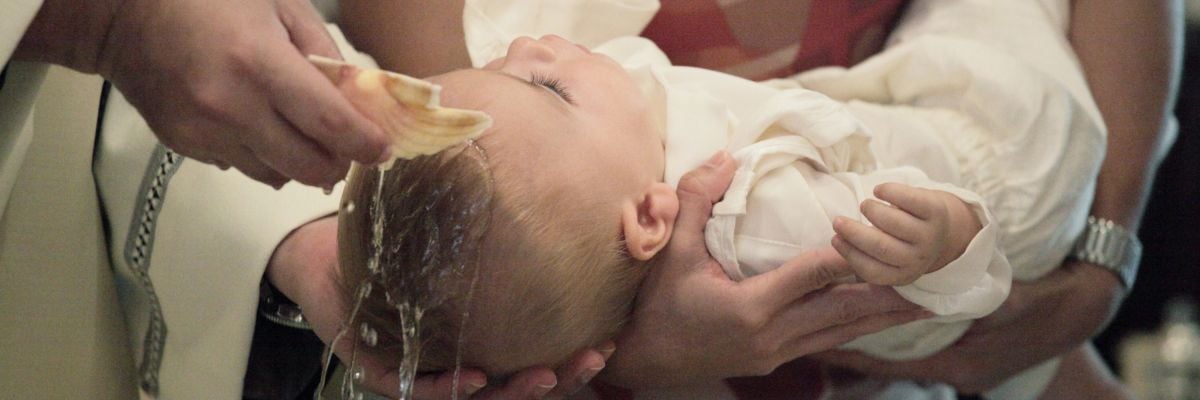
Karlo Broussard critically examines instances of baptism in the New Testament to show why the Church baptizes infants without an explicit command from Scripture.
Host: Let’s go to James in San Antonio, Texas, listening on Guadalupe Radio. James, you’re on with Karlo Broussard.
Caller: Hi, yes, my question is: how come in the book of John, the apostle John goes around baptizing adults and stuff, and yet—I mean, I’m Catholic, and I know that the Catholic Church…like, they baptize the kids when they’re, like, little babies. So how come I don’t hear, like, whenever I go to church and stuff, I don’t hear the priest talk about baptizing adults and stuff, it’s always children.
Karlo: Okay. Alright, well, first of all, the Catholic Church does baptize adults very often. Every Easter Vigil, the majority of the times, you’ll have adults going through baptism in order to be initially incorporated into the Catholic Church. So it’s not that the Church doesn’t baptize adults. The Church baptizes both adults and infants.
Now, with regard to your question concerning, you know, why do we baptize infants when the Bible—in the Bible you have John and you have even the Apostles going around baptizing adults, because, you know, all of those initial converts were all adults, right? So they’re proclaiming the Gospel to adults, for example on the day of Pentecost in Acts chapter 2; Peter preaches the good news of Jesus Christ, 3,000 people convert. You know, they say, “What must we do to be saved,” in essence. You know, they have this compunction in their heart, “What do we gotta do?” Peter’s talking to adults, and so obviously it’s going to be adults who convert, and as Acts 2:38-39 said, they were baptized for the forgiveness of sins.
But what’s interesting, James, is that in Acts 2:38-39, we get a hint that the Holy Spirit and the forgiveness of sins that is administered through baptism is indeed for the children as well, because listen to what Peter says: “Repent and be baptized, every one of you, in the name of Jesus Christ—” and that is to say, by the authority of Jesus Christ, with Jesus’ baptism—“for the forgiveness of your sins. And you shall receive the gift of the Holy Spirit. For the promise is to you and to your children and to all that are far off, every one whom the Lord our God calls to him” [emphasis added]. So, many scholars have looked at that and have seen an implication that the Holy Spirit and the forgiveness of sins that is administered through baptism can be applied to children as well.
And other examples, we have household baptisms in scripture. You might want to check this out, James; for example, Lydia and her household are baptized in Acts 16:15; the jailer and his family are baptized in Acts 16:33; Paul talks about how he baptized the household of Stephanas in 1 Corinthians 1:16. So, now, this doesn’t prove explicitly the early Church baptizing infants, but we do have a hint of households, from which it’s reasonable to conclude there may very well have been infants there.
But what we do see is that on behalf of the faith of these parents here, Lydia and the jailer and Stephanas, you have blessing being administered on the household as well, which is a fundamental principle for understanding of infant baptism—that the faith of the parent brings about merits for the child, this blessing that is administered through the sacrament of baptism.
And finally, James, I would just have to say that, according to St. Paul, in Colossians—let’s see if I get this right—Colossians 2:11-12, for St. Paul, baptism is the new circumcision. What circumcision was for the old covenant, baptism is for the new. So just as infants—particularly male infants, at the time—were able to enter into the covenantal family of God through this visible sign of circumcision, so too in the new covenant, baptism is this “new circumcision” through which one enters into the covenantal family of God in the New Testament. And it’s also extended to male infants, female infants, male adults, female adults.
So you have baptism being the fulfillment of circumcision, which would imply that children can receive this great sacrament as well, to be incorporated into the mystical body of Christ.
To learn more about this topic, check out our church fathers tract, our articles by Tim Staples and John Martignoni, and the entry in our brand-new Bible Navigator.



